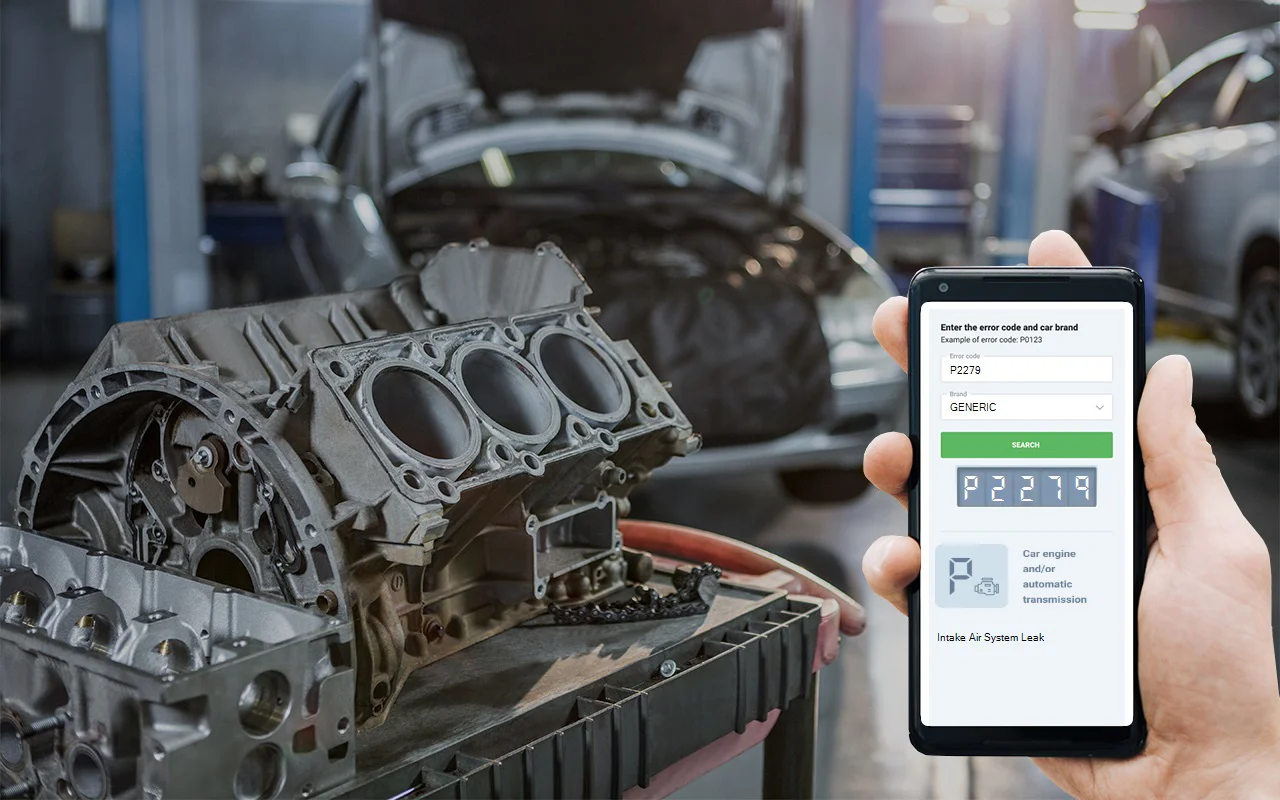The P2279 code is a generic fault code common in brands such as Renault, Toyota, BMW, Kia, Volkswagen, Mercedes, Nissan, Ford, Skoda, and others. It occurs when the ECU (PCM/ECM) detects an input voltage signal indicating a vacuum leak in the engine. Unmetered air enters the engine without being detected by the mass airflow sensor and throttle body. Code P2279 is triggered if the mass airflow sensor, intake air temperature sensor, and oxygen sensor detect discrepancies.
DTC P2279
Causes of OBD P2279
Common causes of this code include:
- Leak in the air intake system on the engine side.
- Gap between the mass airflow sensor and the air intake system.
- Vacuum hose leakage in the brake booster.
- Leak in the intake air temperature sensor.
- Leak in the throttle body.
- Oil filler cap stuck on the crankshaft.
- Disconnected or damaged vacuum hose.
- Crack or leak in the intake manifold.
- Faulty fuel injector seals on the manifold.
- Leak under the dashboard from a vacuum-assisted device.
- Stuck PCV valve (Positive Crankcase Ventilation valve).
Symptoms of P2279 Error
Symptoms of the P2279 code include:
- Check engine light illuminated.
- Significant vacuum leaks may cause engine malfunction or stalling.
- Possible fuel shortage.
- Engine misfire issues.
- Fluctuating fuel consumption.

How to Diagnose DTC P2279?
To diagnose the P2279 fault code, a service technician would perform the following steps:
- Scan the ECU for codes and review freeze-frame data to identify the issue.
- Visually inspect the air intake system for leaks.
- Check the gap between the mass airflow sensor and the air intake system.
- Inspect vacuum hoses for leaks.
- Check the intake air temperature sensor for leaks.
- Examine the throttle body for leaks.
- Inspect vacuum-assisted devices under the dashboard for leaks.
- Check the PCV valve.
- Examine the intake manifold for cracks or leaks.
- Inspect the fuel injector seals on the intake manifold.

How to Avoid Common Mistakes with OBD Code P2279?
Here are some of the most common mistakes that a specialist might make when diagnosing code P2279:
- Failing to thoroughly inspect all wiring and connections.
- Not checking the entire intake air system for leaks.
- Not inspecting the throttle body for vacuum leaks.
- Failing to check the intake air temperature sensor for vacuum leaks.

How Serious is the P2279 Error?
The P2279 code is considered a serious fault and should be resolved as soon as possible. If left unrepaired, it may lead to further engine damage, especially if ignored for an extended period.
How to Fix Code P2279?
Below are solutions that may fix this issue:
- Repair or replace any faulty components, such as wiring, connections, or hoses.
- Clean or replace the mass airflow sensor.
- Check and replace vacuum hoses.
- Replace the intake air temperature sensor.
- Repair or replace the throttle body.
- Identify and seal any detected leaks.
- Repair or replace the intake manifold.
- Replace the fuel injector seals on the intake manifold.
Conclusion
Overall, the P2279 code indicates a fault in the air intake system. It can be caused by various factors, such as leaks in vacuum hoses, cracks or leaks in the intake manifold, or faulty fuel injector seals on the intake manifold. This code should be resolved as soon as possible to avoid further engine damage.
OBD P2279 code analysis and solutions
The page presents a in-depth analysis of code P2279 for Opel, Renault, VW (Volkswagen), Ford, Peugeot, Mitsubishi, Skoda, BMW, Citroën, Toyota, Lada, Honda, Kia, and other models to investigate potential reasons and solutions related to OBD-II errors, with main attention on the issue. We offer technical descriptions and methods for diagnostics to identify and clarify the matter effectively. Our goal is to become a complete resource offering information on issues related to OBD-II errors and to provide you with the tools needed for successful repair and maintenance of your vehicle. If during the fixing of OBD 2 codes you need to purchase parts, don’t forget to visit Avtopro!




